Harry Swinney

The 2012 Lewis Fry Richardson Medal is awarded to Harry Swinney for his pioneering experiments on deterministic chaos and highly original laboratory models of geophysical flows.
Harry Swinney played a leading role in the development of the study of nonlinear processes during the last 40 years. He first showed that the transition to an erratic temporal behaviour of a fluid flow can occur after a small number of bifurcations, thus providing the first experimental demonstration of deterministic chaos. This experimental work triggered a lot of studies among the researchers of different fields who got involved in the study of chaos in the early 1980’s. Swinney then played a pioneering role in the development of new ideas and tools using the methods of dynamical system theory for the analysis of time series: his paper about the determination of Lyapunov exponents (Physica D 16, 285, 1985) has been quoted more than 3000 times by scientists working in many different fields, including atmospheric sciences, oceanography, geophysics, etc. Swinney also made outstanding contributions on pattern-forming instabilities, granular flows and dynamics of fracture. He was the first to achieve the observation of Turing instabilities in chemical dynamics. He made the first observation of coherent structures in granular flows and pioneering contributions to dynamic fracture and acoustic emission from rapidly moving cracks. During his career, Swinney designed very elegant experiments to model nonlinear phenomena in geophysics: the first laboratory study of the dynamics of Jovian-type vortices, a study of anomalous turbulent diffusion in two-dimensional rotating flows, a laboratory model of the atmospheric blocking phenomenon. More recently, he conducted several experiments modeling the dynamics of internal waves over topography in the ocean. Swinney has proven himself, repeatedly and consistently, an international leader in the study of nonlinear processes since the mid-70’s, not only at the scientific level but also to organize and promote this field of research. He was one of the first to bridge the gap between dynamical system theory, laboratory experiments and their application to the study of geophysical flows. He also showed an outstanding ability to bring together different fields of science, in particular at the interface of nonlinear phenomena and Earth and planetary sciences.
